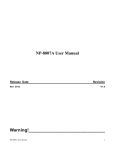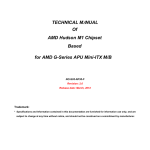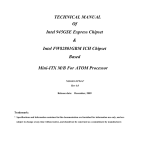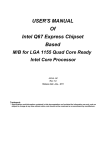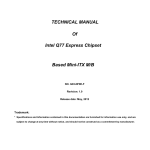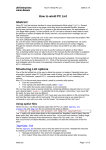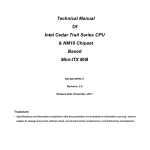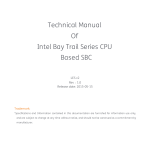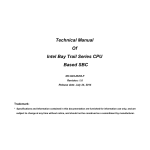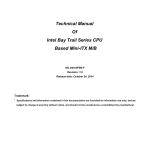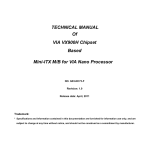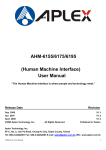Download Connectors
Transcript
AHM-6077 HMI User Manual Release Date Revision Nov 2012 ® 2012 Aplex Technology, Inc. V1.0 All Rights Reserved. Published in Taiwan Aplex Technology, Inc. 15F-1, No.186, Jian Yi Road, Zhonghe District, New Taipei City 235, Taiwan Tel: 886-2-82262881 Fax: 886-2-82262883 E-mail: [email protected] AHM-6077 User Manual URL: www.aplex.com.tw 1 Warning!_______________________________ This equipment generates, uses and can radiate radio frequency energy and if not installed and used in accordance with the instructions manual, it may cause interference to radio communications. It has been tested and found to comply with the limits for a Class A computing device pursuant to FCC Rules, which are designed to provide reasonable protection against such interference when operated in a commercial environment. Operation of this equipment in a residential area is likely to cause interference in which case the user at his own expense will be required to take whatever measures may be required to correct the interference. Electric Shock Hazard – Do not operate the machine with its back cover removed. There are dangerous high voltages inside. Disclaimer This information in this document is subject to change without notice. In no event shall Aplex Technology Inc. be liable for damages of any kind, whether incidental or consequential, arising from either the use or misuse of information in this document or in any related materials. AHM-6077 User Manual 2 Packing List Accessories (as ticked) included in this package are: □ AC power cable □ Driver & manual CD disc □ Other.___________________(please specify) Safety Precautions Follow the messages below to avoid your systems from damage: ◆ Avoid your system from static electricity on all occasions. ◆ Prevent electric shock. Don‘t touch any components of this card when the card is power-on. Always disconnect power when the system is not in use. ◆ Disconnect power when you change any hardware devices. For instance, when you connect a jumper or install any cards, a surge of power may damage the electronic components or the whole system. AHM-6077 User Manual 3 Table of Contents______________________ Warning!…………………………………………………………………………….……..….2 Disclaimer………………………………………………………………….…………………2 Packing List...................................................................................................................3 Safety Precautions........................................................................................................3 Chapter 1 Getting Started 1.1 Specifications………………………………………….………….……...…..6 1.2 Dimensions…………………………………...……………….…………......8 1.3 Brief Description of AHM-6077………….………………….………………9 1.4 Installation of HDD................................................................................10 Chapter 2 Hardware Installation 2.1 Mainboard Specifications……………………………….…………….…12 2.2 Hardware Installation............................................................................15 2.2.1 Jumpers Setting…………….……………………………………………15 2.3 Connectors and Headers......................................................................17 Chapter 3 BIOS Setup 3.1 Entering Setup......................................................................................22 3.2 Getting Help..........................................................................................23 3.3 The Main Menu.....................................................................................23 3.4 Standard CMOS Features................................................................... 24 3.5 Advanced BIOS Features.....................................................................25 3.6 Advanced Chipset Features................................................................. 27 3.7 Integrated Peripherals......................................................................... 28 3.8 Power Management Setup.................................................................. 31 3.9 PnP/PCI Configuration.........................................................................33 3.10 PC Health Status................................................................................34 3.11 Miscellaneous Control.........................................................................35 3.12 Password Setting................................................................................35 3.13 Load Standard/Optimized Defaults.....................................................36 AHM-6077 User Manual 4 Chapter 4 Installation of Drivers 4.1 Intel Chipset Driver.…………………………...……………………………38 4.2 Intel VGA Chipset Driver..…....…......………..................……….......…..41 4.3 Realtek GbE & FE Ethernet PCI-E NIC Driver….......................……….44 4.4 Realtek HD Audio Driver Installation………………….…………………46 Chapter 5 Touch Screen Installation 5.1 Introduction to Touch Screen Controller Board………………………....48 5.2 Windows 2000/XP USB Driver Installation………………….………..….48 Figures Figure 1.1: Dimensions of the AHM-6077…..………………………..………...8 Figure 1.2: Front View of AHM-6077.............................................................9 Figure 1.3: Rear View of AHM-6077..............................................................9 Figure 2.1: Mainboard Layout Diagram…………………………………….…12 Figure 2.2: Jumpers and Connectors Location-TOP…………………...……12 Figure 2.3: Jumpers and Connectors Location- Bottom………………….…13 Figure 5.1: Bird’s Eye View of Control Board…………………………........48 AHM-6077 User Manual 5 Chapter 1________________Getting Started 1.1 Specifications Model No. AHM-6077 Specs System Processor Intel Atom N270 1.6 GHz built-in, FSB 533 MHz System Chipset Intel 945GSE + ICH7M System Memory 1 x 200-pin SO-DIMM socket, support 533 MHz up to 2 GB DDR2 SDRAM Storage 1 x 2.5” SATA HDD 1 x CF Slot (internal) External I/O Port 4 x USB 2.0 ports 1 x RJ-45 ports(GbE) 1 x DB-9 RS-232 COM2 1 x DB-9 RS422/RS485 COM1, default RS485 1 x DVI-I output 1 x Audio Line-out and MIC-in 1 x 3 Pin terminal block DC power input Expansion Slots None OS support Windows CE 6.0, XP Pro, XP Embedded, Windows embedded standard 7 LCD Display Type 7" TFT-LCD Max. Resolution 800X480 Max. Color 262K Luminance (cd/m2) 250 View Angle H:140° / V:110° Backlight Lifetime 20,000 hrs Touch Screen Type Light Transmission Analog resistive 80% Power Supply Power Input DC 11~32V Mechanical Construction AHM-6077 User Manual Aluminum front bezel and steel chassis 6 IP Rating Front Panel IP65 Mounting Panel/VESA 75x75 Mount Dimensions (WxHxD) Net Weight 198x138x73.9 mm 3.6kgs Environmental Operating Temperature Storage Temperature -10~50˚C -20~60 ゚ C Storage Humidity 10~90% @40 ゚ C non-condensing Certificate CE/FCC Class A AHM-6077 User Manual 7 1.2 Dimensions Figure 1.1: Dimensions of the AHM-6077 AHM-6077 User Manual 8 1.3 Brief Description of the AHM-6077 The AHM-6077 is a power-optimized and delivers robust performance-per-watt for embedded HMI. The powered by an Atom N270 1.6 GHz processor. It comes with a compact flash slot, 2.5-inch hard disk drive, DDR2 memory,1 Ethernet, 2 COM ports, DC input, and 4 USB ports. The unit supports Windows CE6.0, XP Pro, XP Embedded and Windows Embedded Standard 7. The fanless touch panel computer is ideal for use as Web Browser, Terminal and HMI at all levels of automation control. Figure 1.2: Front View of AHM-6077 Figure 1.3: Rear View of AHM-6077 AHM-6077 User Manual 9 1.4 Installation of HDD Step 1 There are 2 screws to deal with when Installing of HDD as shown in the picture AHM-6077 Step 2 Loosen screw and draw the HDD bracket out as shown in the picture.as shown in the picture AHM-6077 Step 3 Tighten four screws as shown in the picture. AHM-6077 User Manual 10 Step 4 Push into the HDD bracket as shown in the picture AHM-6077 Step 5 Tighten the 2 screws as shown in the picture. That’s how it should look after it has been installed. AHM-6077 User Manual 11 Chapter 2__________Hardware Installation 2.1 Mainboard Specifications Figure 2.1: Layout Diagram Figure 2.2: Jumpers and Connectors Location-TOP AHM-6077 User Manual 12 Figure 2.3: Jumpers and Connectors Location- Bottom Spec Description Chipset 3.5”SBC 6 layers; PCB size: 14.8x 10.2 cm Intel 945GSE+ICH7M Chipset Embedded CPU ATOM CPU Memory Socket 200-pin DDRII SO-DIMM slot x1 Support DDRII 400/533MHz system Modules DDRII memory Expandable to 2GB. CF card slot x1 Mini-PCI E slot x1 One PCI IDE controller that supports PCI Bus Mastering, ATA PIO/DMA and the ULTRA DMA /100/66 functions that deliver the data transfer rate up to 100MB/s. Integrated Realtek RTL8111DL PCI-E Gigabit LAN. Support Fast Ethernet LAN function of providing 10Mb/100Mb/1000Mb Ethernet data transfer rate ALC662 2-channel HD Audio Codec integrated Audio driver and utility included Award 8MB DIP Flash ROM DVI connector x1 USB 2.0 port x 4 and USB header x1 RJ-45 gigabit LAN connector x1 Audio connector x2 (Line out/MIC connector) Design Expansion Slots Integrate IDE LAN HD Audio BIOS Multi I/O AHM-6077 User Manual 13 SATAII x1 VGA header x1 Front panel header x1 RS422/485 header x2 LVDS connector x1 GPIO connector x1 SYSTEM FAN header x1 Jumper Jumper Name Description JCOM1 COM1 RS232/422/485 Function Select 6-pin Block JCOMP1 RS232 Power on Function Select 6-pin Block JP1 Inverter VCC 12V/5V Select 3-pin Block JP2 LVDS5V/3.3V Select 3-pin Block JP3 CF Card Master/Slave Mode Select 3-pin Block Connectors Connector Name Description DC12V2 DC Power Connector DC Jack USB3/ USB2 USB Port Connectors 4-pin Connectors DVI1 DVI Port Connector 24-pin Connector LAN1 RJ-45 LAN Connector 8-pin Connector HOUT1 Line Out Connector 1-phone Jack HMIC1 MIC Connector 1-phone Jack SATA1 Serial ATAII 7-pin Connector PWOUT1 Power Out Connector Connector 4-pin Connector Headers Header Name Description AUDIO1 Front Panel Audio Header 9-pin block USB1 USB header 9-pin block COM1,COM2 Serial port headers 9-pin block TX-RXCOM1 RS422/485 header 4-pin block JW_FP1 Front Panel Header 8-pin Block (PWR LED/ HD LED/ (PWR LED/ HD LED/ /Power Button /Power Button /Reset) /Reset) SFAN1 FAN Speed Headers 3-pin Block IDE1 IDE Hard Disk Drive header 44-pin block GPIO GPIO header 10-pin block LVDS1 LVDS Connector 30-pin Block INVERTER1 LVDS Inverter Connector 7-pin Block VGA1 VGA Port Header 15-pin Connectors AHM-6077 User Manual 14 2.2 Hardware Installation 2.2.1 Jumper Setting (1) JCOM1: COM1 Port RS232/422/485 function select JCOM1 1 1 1 1-2 closed: RS232 3-4 closed : RS485 5-6 closed : RS422 (2) JCOMP1: COM1 Pin 9 function select JCOMP1 1 1 1-2 c l o s :eRd S 2 3 2 3-4 c l o s e :d+ 1 2 V 1 5-6 c l o s e :d+ 5 V **COM1 Pin Define Pin 1 RX+ 2 RX- 3 TX- 4 TX+ (3) JP1: Inverter VCC 5V/12Vselect (3-pin) 1 JP1 3 1 JP1 1-2 c l o s e d Inverter 12V selected 2-3 c l o s e d Inverter 5V select 3 AHM-6077 User Manual 15 (4) JP2: LVDS 5V/3.3V Function setting (3-pin) JP2 JP2 1 3 1-2 closed: LVDS VCC 5V 1 3 2-3 closed : LVDS VCC 3.3V (5) JP3: CF card Master /Slave Mode setting (3-pin) 1 JP3 1 JP3 3 1-2 closed: CF Card Slave AHM-6077 User Manual 3 2-3 closed :CF Card Master 16 2.3 Connectors and Headers 2.3.1 Connectors (1) Audio Connector: (Line-Out/ MIC-In) (2) Serial-ATA Port connector: SATA1 SATA1 Serial-ATA Connectors AHM-6077 User Manual 17 2.3.2 Headers AUDIO NC GND Front panel audio (9-pin): AUDIO1 NC NC KEY (1) 2 10 Pin 1 SENSE LINTOUT-L LINEOUT-R MIC1-R MIC2-L 9 Line-Out, MIC Headers -CTS RI NC COM Connectors (9-pin): COM1/COM2 -DSR -RTS (2) GND -DCD -SIN SOUT -DTR Pin1 Serial Port 9-pin Block AHM-6077 User Manual 18 TXDN RXDN (3)TX-RXCOM Header: TX-RXCOM1 Pin 2 TXDP RXDP Pin 1 TX-RXCOM1 Header H D L E D V C C 5 S ys t e m (5) P i n 1 D= P W R L E D + H D D L E D P W LR E D P W R B T N P W R L - E D 1F P P W R B T NG N D J W G N D R E S E T R S T S W (4) JW-FP1(8-pin) C a s e C o n n e c t i o n s SFAN1 Headers (3-pin): SYSFAN1 DET VCC12V GND 3 1 Fan Header GND GP13 GP12 GP11 GP10 O (6) GPIO1 Connectors (10-pin): GPIO Pin 1 VCC GP65 GP64 GP63 GP17 2 GPIO Connector AHM-6077 User Manual 19 (7)LVDS Headers: LVDS1 LVDS Header Pin 1 P i n2 Pin NO. Pin Define Pin NO. Pin Define Pin 1 NC Pin 2 NC Pin 3 LVDS_CLKBN Pin 4 LVDS_CLKBP Pin 5 LVDSB_DATAN2 Pin 6 LVDSB_DATAP2 Pin 7 LVDSB_DATAN1 Pin 8 LVDSB_DATAP1 Pin 9 LVDSB_DATAN0 Pin 10 LVDSB_DATAP0 Pin 11 LVDS_DDC_DATA Pin 12 LVDS_DDC_CLK Pin 13 GND Pin 14 GND in 15 GND Pin 16 GND Pin 17 NC Pin 18 NC Pin 19 LVDS_CLKAP Pin 20 Pin 21 LVDSA_DATAP2 Pin 22 Pin 23 LVDSA_DATAP1 Pin 24 Pin 25 LVDSA_DATAP0 Pin 26 Pin 27 PVDD Pin 28 Pin 29 PVDD Pin 30 AHM-6077 User Manual LVDS_CLKAN LVDSA_DATAN2 LVDSA_DATAN1 LVDSA_DATAN0 PVDD PVDD 20 (8) Pin-headers of LVDS Inverter: INVERTER1 Pin 1 INVERTER Pin NO. Pin Define Pin 1 VCC Pin 2 VCC Pin 3 GND Pin 4 GND Pin 5 Backlight Pin 6 GND Pin 7 Bright AHM-6077 User Manual 21 Chapter 3 BIOS Setup The BIOS is a program located on a Flash Memory on the motherboard. This program is a bridge between motherboard and operating system. When you start the computer, the BIOS program will gain control. The BIOS first operates an auto-diagnostic test called POST (power on self test) for all the necessary hardware, it detects the entire hardware device and configures the parameters of the hardware synchronization. Only when these tasks are completed done it gives up control of the computer to operating system (OS). Since the BIOS is the only channel for hardware and software to communicate, it is the key factor for system stability, and in ensuring that your system performance as its best. In the BIOS Setup main menu of Figure 3-1, you can see several options. We will explain these options step by step in the following pages of this chapter, but let us first see a short description of the function keys you may use here: Press <Esc> to quit the BIOS Setup. Press (up, down, left, right) to choose, in the main menu, the option you want to confirm or to modify. Press <F10> when you have completed the setup of BIOS parameters to save these parameters and to exit the BIOS Setup menu. Press Page Up/Page Down or +/– keys when you want to modify the BIOS parameters for the active option. 3.1 Entering Setup Power on the computer and by pressing <Del> immediately allows you to enter Setup. If the message disappears before your respond and you still wish to enter Setup, restart the system to try again by turning it OFF then ON or pressing the “RESET” button on the system case. You may also restart by simultaneously pressing <Ctrl>, <Alt> and <Delete> keys. If you do not press the keys at the correct time and the system does not boot, an error message will be displayed and you will again be asked to Press <Del> to enter Setup AHM-6077 User Manual 22 3.2 Getting Help Main Menu The on-line description of the highlighted setup function is displayed at the bottom of the screen. Status Page Setup Menu/Option Page Setup Menu Press F1 to pop up a small help window that describes the appropriate keys to use and the possible selections for the highlighted item. To exit the Help Window, press <Esc>. 3.3 The Main Menu Once you enter Award BIOS CMOS Setup Utility, the Main Menu (Figure 3-1) will appear on the screen. The Main Menu allows you to select from fourteen setup functions and two exit choices. Use arrow keys to select among the items and press <Enter> to accept or enter the sub-menu. Figure 3-1 Standard CMOS Features Use this Menu for basic system configurations. Advanced BIOS Features Use this menu to set the Advanced Features available on your system. Advanced Chipset Features Use this menu to change the values in the chipset registers and optimize your system’s performance. Integrated Peripherals Use this menu to specify your settings for integrated peripherals. Power Management Setup Use this menu to specify your settings for power management. PnP/PCI Configuration Use this menu to specify your settings for PnP and PCI configurations. AHM-6077 User Manual 23 PC Health Status This entry shows your PC health status. Miscellaneous Control Use this menu to specify your settings for Miscellaneous Control. Load Optimized Defaults Use this menu to load the BIOS default values these are setting for optimal performances system operations for performance use. Load Standard Defaults Use this menu to load the BIOS default values for the minimal/stable performance system operation Set Supervisor Password Use this menu to set supervisor password. Set User Password Use this menu to set user password. Save & Exit Setup Save CMOS value changes to CMOS and exit setup. Exit Without Saving Abandon all CMOS value changes and exit setup. 3.4 Standard CMOS Features The items in Standard CMOS Setup Menu are divided into several categories. Each category includes no, one or more than one setup items. Use the arrow keys to highlight the item and then use the <PgUp> or <PgDn> keys to select the value you want in each item. Date AHM-6077 User Manual 24 The date format is <day><month><date><year>. Day Day of the week is from Sun to Sat, determined by BIOS. Read-only. Month The month is from Jan. through Dec. Date The date from 1 to 31 can be keyed by numeric function keys. Year The year depends on the year of the BIOS. Time The time format is <hour><minute><second>. SATA Port1 Master/IDE Channel Master/Slave Press Enter to enter the subitem and then press PgUp/<+> or PgDn/<–> to select None, Auto type. Note that the specifications of your drive must match with the drive table. If the controller of HDD interface is SCSI, the selection shall be “None”. If the controller of HDD interface is CD-ROM, the selection shall be “None” Access Mode The settings are CHS, LBA, Large and Auto. Capacity The capacity of the hard disk driver. Cylinder number of cylinders Head number of heads Precomp write precomp Landing Zone landing zone Sector number of sectors Video The optional settings are: EGA/VGA; CGA40; CGA80; Mono. Halt On Three optional settings are: All Errors; No Errors; All, But Keyboard. 3.5 Advanced BIOS Features Virus Warning The selection Allow you to choose the VIRUS Warning feature for IDE Hard Disk boot sector protection. If this function is enabled and someone attempt to write data into this area, BIOS will show a warning message on screen and alarm beep. Disabled (default) No warning message to appear when anything attempts to access the boot sector or AHM-6077 User Manual 25 hard disk partition table. Enabled Activates automatically when the system boots up causing a warning message to appear when anything attempts to access the boot sector of hard disk partition table. Hard Disk Boot Priority The selection is for you to choose the hard disk drives priorities to boot from. Quick Power On Self-Test This category speeds up Power On Self Test (POST) after you power on the computer. If this is set to Enabled, BIOS will shorten or skip some check items during POST. Enabled (default) Enable quick POST Disabled Normal POST First/Second/Third Boot Device The BIOS attempts to load the operating system from the devices in the sequence selected in these items. The optional settings are:Removable; Hard Disk; CDROM; Network;Disabled.. Boot Up NumLock Status The default value is On. On (default) Keypad is numeric keys. Off Keypad is arrow keys. Typematic Rate Setting Keystrokes repeat at a rate determined by the keyboard controller. When enabled, the typematic rate and typematic delay can be selected. The settings are: Enabled/Disabled. Typematic Rate (Chars/Sec) Sets the number of times a second to repeat a keystroke when you hold the key down. The settings are: 6, 8, 10, 12, 15, 20, 24, and 30. Typematic Delay (Msec) Sets the delay time after the key is held down before beginning to repeat the keystroke. 250, 500, 750, and 1000. Security Option The settings are This category allows you to limit access to the system and Setup, or just to Setup. System The system will not boot and access to Setup will be denied if the correct password is not entered at the prompt. Setup (default) The system will boot, but access to Setup will be denied if the correct password is not entered prompt. MPS Version Control for OS 1.4 This option is only valid for multiprocessor motherboards as it specifies the version of the Multiprocessor Specification (MPS) that the motherboard will use. OS Select for DRAM > 64MB Allows OS2 to be used with >64MB or DRAM. Settings are Non-OS/2 (default) and OS2. Set to OS/2 if using more than 64MB and running OS/2. HDD S.M.A.R.T Capability This option allow you to enable the HDD S.M.A.R.T Capability (Self-Monitoring, Analysis and Reporting Technology) . You can choose from Enabled and Disabled. AHM-6077 User Manual 26 3.5.1 CPU Features Limit CPUID Maxval This option supports the max ID of comparatively old processor. CPU C State Compatibility The optional settings are: Disabled; C2; C4. Enhanced Intel Speedstep Tech This option can provide average power savings depending on system usage and design. 3.6 Advanced Chipset Features The Advanced Chipset Features Setup option is used to change the values of the chipset registers. These registers control most of the system options in the computer. AHM-6077 User Manual 27 DRAM Timing Selectable The optional settings are: By SPD; Manual. If you chose Manual, you could activate the four items following it and make modification manually. System BIOS Cacheable Selecting Enabled allows caching of the system BIOS ROM at F0000h-FFFFFh, resulting in better system performance. However, if any program writes to this memory area, a system error may result. The settings are: Enabled and Disabled. OnChip Frame Buffer Size The optional settings are: 1MB; 8MB. DVMT Memory Memory Size The optional settings are: 64 MB; 128MB; 224MB. Boot Display The optional settings are: Auto; CRT; DVI; LVDS; CRT+LVDS; CRT+DVI. 3.7 Integrated Peripherals AHM-6077 User Manual 28 3.7.1 Onboard IDE Function IDE Channel Master/Slave PIO The two IDE PIO (Programmed Input/Output) fields let you set a PIO mode (0-4) for each of the two IDE devices that the onboard IDE interface supports. Modes 0 through 4 provide successively increased performance. In Auto mode, the system automatically determines the best mode for each device. The settings are: Auto, Mode 0, Mode 1, Mode 2, Mode 3, Mode 4. IDE Channel Master/Slave UDMA Ultra DMA/33 implementation is possible only if your IDE hard drive supports it and the operating environment includes a DMA driver (Windows 95 OSR2 or a third-party IDE bus master driver). If your hard drive and your system software both support Ultra DMA133, select Auto to enable BIOS support. The settings are: Auto, Disabled. IDE DMA Transfer Access The integrated peripheral controller contains an IDE interface with support for one IDE channels. Select Enabled to activate each channel separately. The settings are: Enabled and Disabled. IDE HDD Block Mode Block mode is also called block transfer, multiple commands, or multiple sector read/write. If your IDE hard drive supports block mode (most new drives do), select Enabled for automatic detection of the optimal number of block read/writes per sector the drive can support. The settings are: Enabled, Disabled. Delay for HDD (Sec.) The optional settings range from 0 to 15 seconds. SATA Port Speed Settings The optional settings are: Disabled; Force GENI; Force GEN II. AHM-6077 User Manual 29 3.7.2 Onboard Device Function High Definition Audio This item allows you to decide to enable/disable the chipset family to support HD Audio. are: Enabled, Disabled. The settings USB 2.0 Function Use this item to enable or disable USB 2.0 function. USB Operation Mode The optional settings are:Full/Low Speed; High Speed. USB Keyboard/Mouse /Storage Legacy Support Select Enabled if your system contains a Universal Serial Bus (USB) controller and you have a USB mouse /keyboard/USB storage device. The settings are: Enabled, Disabled. AHM-6077 User Manual 30 3.7.3 Onboard SuperIO Function Onboard Serial Port 1/2 The optional settings are:Disabled, 3F8/IRQ4,2F8/IRQ3, 3E8/IRQ4,2E8/IRQ3. Onboard Serial Port1 Mode The optional settings are: RS232; RS422/RS485. Watchdog Timer Select This item is used to activate the watchdog function. The optional settings are: Enabled; Disabled. When set it as Enabled user can choose configuration figures in subitems. Watchdog Timer Value This item is only activated when Watchdog Timer Select is set as Enabled and users can set a value from the range of 1~255. Watchdog Timer Unit This item is only activated when Watchdog Timer Select is set as Enabled and the optional units are: Sec. and Min. *Note: User needs an additional Watchdog Programming Reference Code to make use of this BIOS function. Detailed procedures please download from our website if necessary. The Delay Time for S5 users can set a value from the range of 1~255. 3.8 Power Management Setup The Power Management Setup allows you to configure your system to most effectively save energy saving while operating in a manner consistent with your own style of computer use. AHM-6077 User Manual 31 ACPI Suspend Type Use this item to select ACPI suspend type. The optional settings are: S1(POS); S3 (STR). Power Management The optional settings are: User Define; Min Saving; Max Saving. Video Off Method This determines the manner in which the monitor is blanked. Blank Screen This option only writes blanks to the video buffer. V/H SYNC+Blank This selection will cause the system to turn off the vertical and horizontal synchronization ports and write blanks to the video buffer. DPMS Initial display power management signaling. Video Off in Suspend The optional settings are: Yes; No. Suspend Type The optional settings are: Stop Grant; PwrOn Suspend. MODEM Use IRQ If you want an incoming call on a modem to automatically resume the system from a power-saving mode, use this item to specify the interrupt request line (IRQ) that is used by the modem. You might have to connect the fax/modem to the motherboard Wake On Modem connector for this feature to work. Soft-Off by PWRBTN Under ACPI (Advanced Configuration and Power management Interface) you can create a software power down. In a software power down, the system can be resumed by Wake up Alarms. This item lets you install a software power down that is controlled by the power Button on your system. If the item is set to Instant-Off, then the power button causes a software power down. If the item is set to Delay 4 Sec, then you have to hold the power button down for four seconds to cause a software power down. EUP Function The optional settings are: Enabled; Disabled. User can set it as Enabled to select the relative items for AHM-6077 User Manual 32 the follwoing wake up events: Power on by Ring, Wake-Up by USB KB from S3(S4), and Resume by Alarm. Resume by Alarm When set to Enabled, additional fields become available and you can set the date (day of the month), hour, minute and second to turn on your system. When set to 0 (zero) for the day of the month, the alarm will power on your system every day at the specified time . Date (of month) You can choose which month the system will boot up. settings range from 0 to 31 Set to 0, to boot every day.The optional Time (hh:mm:ss) You can choose what hour, minute and second the system will boot up. Note: If you have change the setting, you must let the system boot up until it goes to the operating system, before this function will work. 3.9 PnP/PCI Configuration PCI/VGA Palette Snoop This item is designed to overcome problems that can be caused by some non-standard VGA cards. This board includes a built-in VGA system that does not require palette snooping so you must leave this item disabled. IRQ Resources Names the interrupt request (IRQ) line assigned to the USB on your system. Activity of the selected IRQ always awakens the system. AHM-6077 User Manual 33 3.10 PC Health Status This section shows the Status of you CPU, Fan, and Warning for overall system status. This is only available if there is Hardware Monitor onboard. Shutdown Temperature This item can let users setting the Shutdown temperature, when CPU temperature over this setting the system will auto shutdown to protect CPU. CPU Thermal Throttling The optional settings are: Disabled; Enabled. When it is set as Enabled user could set value for CPU Thermal-Throttling Temp.; CPU Thermal-Throttling Duty and CPU Thermal-Throttling Beep. Show PC Health in Post During Enabled, it displays information list below. The choice is either Enabled or Disabled +5V OUT/+12V OUT/Vcc3V OUT User can set is Disabled or select to add a value in the range of +5% to +35%. Smart Fan Configuration The optional settings are: Disabled; Enabled. When it is set as Enabled user could set value for SYS FAN1 Full-Speed Temp., SYS FAN1 Idle Temp. and SYS FAN1 IDLE-Speed Duty. VCC3V/Vcore/ /NB/5 VSB /VDIMM/+5V/+12V/ VSB3V/Vbat/ CPU Temperature/ System Temperature/ SYSFAN1 Speed/ This will show the CPU/FAN/System voltage chart and FAN Speed. AHM-6077 User Manual 34 3.11 Miscellaneous Control CPU Clock Ratio Unclock This item is used to lock or unlock CPU ratio. CPU Clock Ratio The optional settings range from 6X to 12X. DRAM Clock at Next Boot This item allows you to set DRAM clock. The optional settings are:By SPD(DDR 533); 400MHz; 533MHz.. 3.12 Password Setting You can set either supervisor or user password, or both of them. The differences are: Supervisor password: User password: Can enter and change the options of the setup menus. Can only enter but do not have the right to change the options of the setup menus. When you select this function, the following message will appear at the center of the screen to assist you in creating a password. ENTER PASSWORD: Type the password, up to eight characters in length, and press <Enter>. The password typed now will clear any previously entered password from CMOS memory. Type the password again and press <Enter>. You will be asked to confirm the password. You may also press <Esc> to abort the selection and not enter a password. To disable a password, just press <Enter> when you are prompted to enter the password. confirm that the password will be disabled. A message will Once the password is disabled, the system will boot and you can enter Setup freely. PASSWORD DISABLED. When a password has been enabled, you will be prompted to enter it every time you try to enter Setup. AHM-6077 User Manual 35 This prevents an unauthorized person from changing any part of your system configuration. Additionally, when a password is enabled, you can also require the BIOS to request a password every time your system is rebooted. This would prevent unauthorized use of your computer. You determine when the password is required within the BIOS Features Setup Menu and its Security option. If the Security option is set to “System”, the password will be required both at boot and at entry to Setup. If set to “Setup”, prompting only occurs when trying to enter Setup. 3.13 Load Standard/Optimized Defaults Load Standard Defaults When you press <Enter> on this item, you get confirmation dialog box with a message similar to: Pressing <Y> loads the BIOS default values for the most stable, minimal-performance system operations. Load Optimized Defaults When you press <Enter> on this item, you get a confirmation dialog box with a message similar to: Pressing <Y> loads the default values that are factory settings for optimal performance system operations. AHM-6077 User Manual 36 Chapter 4 Installation of Drivers This chapter describes the installation procedures for software and drivers under the windows XP. The software and drivers are included with the motherboard. The contents include Intel chipset driver, VGA driver, LAN driver, Audio driver, Touch Panel driver Installation instructions are given below. Important Note: After installing your Windows operating system (Windows XP), you must install first the Intel Chipset Software Installation Utility before proceeding with the installation of drivers. I AHM-6077 User Manual 37 4.1 Intel Chipset Driver To install the Intel chipset driver, please follow the steps below. Step 1: Select Chipset from the list Follow the step-by-step installation process to install the LMS_SQL driver. AHM-6077 User Manual 38 AHM-6077 User Manual 39 Click Finish, when the installation process is complete, the Setup Complete screen appears. See as picture. AHM-6077 User Manual 40 4.2 Intel VGA Chipset Driver To install the VGA drivers, follow the steps below to proceed with the installation. 1. Click Intel VGA Chipset Driver. Follow the step-by-step installation process to install the Graphics Media Accelerator driver. AHM-6077 User Manual 41 AHM-6077 User Manual 42 Click FINISH; A Driver Installation Complete. AHM-6077 User Manual 43 4.3 Realtek GbE & FE Ethernet PCI-E NIC Driver To install the Realtek GbE & FE Ethernet PCI-E NIC Driver, please follow the steps below. Select LAN from the list Follow the step-by-step installation process to install the LAN driver. AHM-6077 User Manual 44 Click FINISH; A Driver Installation Complete. AHM-6077 User Manual 45 4.4 Realtek HD Audio Driver Installation To install the Realtek High Definition (HD) Audio driver, please follow the steps below. Select Audio from the list Follow the step-by-step installation process to install the Realtek HD Audio driver. AHM-6077 User Manual 46 Click FINISH; A Driver Installation Complete. AHM-6077 User Manual 47 Chapter 5 Touch Screen Installation This chapter describes how to install drivers and other software that will allow your PenMount 6000 Controller Board to work with different operating systems. NOTE: PenMount USB drivers support up to 15 USB controllers. 5.1 Introduction to Touch Screen Controller Board PenMount 6300 USB control board is a touch screen control board designed for USB interface and specific for 4, 5, 8-wire touch screens. It is designed with USB interface features with multiple devices supporting function. PenMount 6300 control board using PenMount 6000 controller that has been designed for those who may like and all-in-one solution with 10-bit A/D converter built-in to make the total printed circuit board denser, circuit diagram also designed for 12-bit ADC for optional. There are two connectors on this board, one connector is for 4, 5, 8-wire touch screen cable (optional), and another is for 4-pin USB A type cable (optional). Figure 5.1: Bird’s Eye View of Control Board 5.2 Windows 2000/XP/2003/Vista Universal Driver Installation for PenMount 6000 Series Before installing the Windows 2000/XP driver software, you must have the Windows 2000/XP system installed and running on your computer. You must also have one of the following PenMount 6000 series controller or control boards installed: PM6500, PM6300. AHM-6077 User Manual 48 5.2.1 Installing Software If you have an older version of the PenMount Windows 2000/XP driver installed in your system, please remove it first. Follow the steps below to install the PenMount DMC6000 Windows 2000/XP driver. 1. Please make sure your PenMount 6000 device had plugged in advance. If your device uses RS232 interface, please plugged in before the machine is turned on. When the system first detects the controller board, a screen appears that shows “Unknown Device”. Do not use this hardware wizard. Press Cancel. 2. Insert the Aplex product CD install setup.exe. the screen below would appear. Click touch panel driver AHM-6077 User Manual 49 3. A License Agreement appears. Click “I Agree…” and “Next” AHM-6077 User Manual 50 4. Ready to Install the Program. Click “Install” AHM-6077 User Manual 51 5. Installing 6. The “Install Shield Wizard Completed” appears. Click “Finish”. AHM-6077 User Manual 52 5.2.2 Software Functions Upon rebooting, the computer automatically finds the new 6000 controller board. The touch screen is connected but not calibrated. Follow the procedures below to carry out calibration. 1. After installation, click the PenMount Monitor icon “PM” in the menu bar. 2. When the PenMount Control Panel appears, select a device to “Calibrate.” PenMount Control Panel The functions of the PenMount Control Panel are Device, Multiple Monitors, Tools and About, which are explained in the following sections. Device In this window, you can find out that how many devices are detected on your system. Calibrate This function offers two ways to calibrate your touch screen. ‘Standard Calibration’ adjusts most touch screens. ‘Advanced Calibration’ adjusts aging touch screens. Standard Calibration Click this button and arrows appear pointing to red squares. Use your finger or stylus to touch the red squares in sequence. After the fifth red point calibration is complete. To skip, press ‘ESC’. AHM-6077 User Manual 53 Advanced Calibration Advanced Calibration uses 4, 9, 16 or 25 points to effectively calibrate touch panel linearity of aged touch screens. Click this button and touch the red squares in sequence with a stylus. To skip, press ESC’. Command Calibration Command call calibration function. Use command mode call calibration function, this can uses Standard, 4, 9, 16 or 25 points to calibrate E.g. Please run ms-dos prompt or command prompt c:\Program Files\PenMount Universa Driver\Dmcctrl.exe -calibration 0 ( Standard Calibration) Dmcctrl.exe - calibration ($) 0= Standard Calibration 4=Advanced Calibration 4 9=Advanced Calibration 9 16=Advanced Calibration 16 25=Advanced Calibration 25 1. Please select a device then click “Configure”. You can also double click the device too. 2.Click “Standard Calibration” to start calibration procedure AHM-6077 User Manual 54 NOTE: The older the touch screen, the more Advanced Mode calibration points you need for an accurate calibration. Use a stylus during Advanced Calibration for greater accuracy. Please follow the step as below: 3.Come back to “PenMount Control Panel” and select “Tools” then Click “Advanced Calibration”. AHM-6077 User Manual 55 Select “Device” to calibrate, then you can start to do “Advanced Calibration”. NOTE: Recommend to use a stylus during Advanced Calibration for greater accuracy. AHM-6077 User Manual 56 Setting AHM-6077 User Manual 57 About This panel displays information about the PenMount controller and driver version. AHM-6077 User Manual 58 Multiple Monitors Multiple Monitors supports from two to six touch screen displays for one system. The PenMount drivers for Windows 2000/XP support Multiple Monitors. This function supports from two to six touch screen displays for one system. Each monitor requires its own PenMount touch screen control board, either installed inside the display or in a central unit. The PenMount control boards must be connected to the computer COM ports via the RS-232 interface. Driver installation procedures are the same as for a single monitor. Multiple Monitors supports the following modes: Windows Extend Monitor Function Matrox DualHead Multi-Screen Function nVidia nView Function NOTE: The Multiple Monitors function is for use with multiple displays only. Do not use this function if you have only one touch screen display. Please note once you turn on this function the Rotating function is disabled. Enable the multiple display function as follows: 1. Check the “Multiple Monitor Support” box; then click “Map Touch Screens” to assign touch controllers to displays. 2. When the mapping screen message appears, click “OK” AHM-6077 User Manual 59 3. Touch each screen as it displays “Please touch this monitor. Press ‘S’ to skip” Following this sequence and touching each screen is called mapping the touch screens. 4. After the setting procedure is finished, maybe you need to calibrate for each panel and controller NOTES: 1. If you used a single VGA output for multiple monitors, please do not use the Multiple Monitors function. Just follow the regular procedure for calibration on each of your desktop monitors. 2. The Rotating function is disabled if you use the Multiple Monitors function. 3. If you change the resolution of display or screen address, you have to redo Map Touch Screens so the system understands where the displays are. 4. If you more monitor mapping one touch screen, Please press ‘S’ to skip mapping step. AHM-6077 User Manual 60 Tools Draw Tests or demonstrates the PenMount touch screen operation. Advanced Calibration Enable Advanced Calibration function Right Button Icon Enable right button function. The icon can show on Desktop or System Tray (menu bar). About You can see how many devices of PenMount controller that are plugged to your system AHM-6077 User Manual 61 PenMount Monitor Menu Icon The PenMount monitor icon (PM) appears in the menu bar of Windows 2000/XP system when you turn on PenMount Monitor in PenMount Utilities. PenMount Monitor has the following function PenMount Rotating Functions The PenMount driver for Windows 2000/XP supports several display rotating software packages. AHM-6077 User Manual 62 Windows Me/2000/XP support display rotating software packages such as: • Portrait’s Pivot Screen Rotation Software • ATI Display Driver Rotate Function • nVidia Display Driver Rotate Function • SMI Display Driver Rotate Function • Intel 845G/GE Display Driver Rotate Function Configuring the Rotate Function 1. Install the rotation software package. 2. Choose the rotate function (0°, 90°, 180°, 270°) in the 3rd party software. The calibration screen appears automatically. Touch this point and rotation is mapped. NOTE: The Rotate function is disabled if you use Monitor Mapping AHM-6077 User Manual 63































































